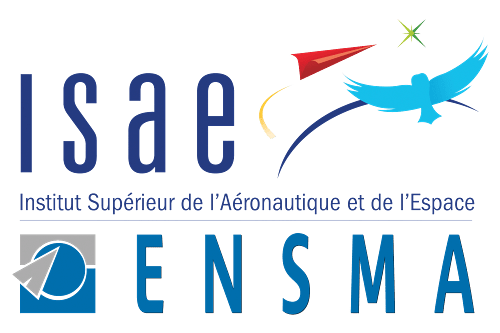ENSMA’s origin and history
« Circumstances and people »
Jacques de Fouquet (Emeritus director)

Could ENSMA be the consequence of a mistake? One day in 1927, a young second lieutenant from Poitiers, who had just graduated from Ecole Normale Supérieure after a short time spent at Polytechnique, was wandering in the corridors of the Sorbonne, during a leave, looking for the place where a mathematics lecture was to be held.
By chance, he went to the wrong room and entered a lecture hall where a conference on fluid dynamics was being held. The lecturer was H. Villat, later on President of the Academy of Sciences. This second lieutenant was H. Poncin, the founding father of ENSMA.
Combining the young graduate’s curiosity for a brand new topic, the lecturer’s talent and conviction, this mistake led him to change his career path. When he left the Army, he started research on heavy fluids and cavitation behaviour under the supervision of H. Villat.
Around 13 years later, he was appointed professor of Rational Mechanics at the University of Poitiers. There H. Poncin was reunited with one of his high school classmates, C. Chartier who was then focusing on the chronophotogrametry of flows.
Although the Occupation did not give them much freedom, the Poncin-Chartier duo undertook to create a mechanics laboratory in the cramped university facilities, located at that time on University Street. It was successively equipped with a channel with water movement, an Eiffel wind tunnel supplied by street air, and also a supersonic wind tunnel, whose powering of the 130 CC’s engine with electricity confronted them with some connection problems.
They then decided to complete the training of the bachelor students with courses such as engineering design project and technical drawing.
Fortunately, a graduate student from the higher education institute for industrial art and design from the city of Dissay, had recently got back to Poitiers as a professor of technical education after a few years working on wiredrawing. M. Saigne, future ENSMA deputy director, was quickly integrated into the team thanks to his technological and designing skills.
After the Liberation, Aeronautical Research Centres were created under the aegis of the Technical and Industrial Management Department (D.T.I.) of the Air Ministry and in close collaboration with the Ministry of Education.
From 1945, an agreement between the D.T.I., the University of Paris and the University of Poitiers allowed to create an institute of mechanics specialized in the study of solids and fluids, named the Institute of Mechanical and Aeronautical Engineering of Poitiers (IMAP). To teach the “Solids” course, a professor from Nantes, who had defended his PhD in 1943 on “Crystalline dislocations in metal by simple and reversed torsions”, was hired. R. Jacquesson came to Poitiers in 1946 as a professor of Solid Mechanics, a position supported by the Air Ministry, as well as the one in fluid mechanics held by M. Chartier at the same time.
When, in January 1947, the decree institutionalizing E.N.S.I.s was published, the situation was ideal for I.M.A.P. to give way naturally to the “Ecole Nationale Supérieure de Mécanique et d’Aérotechnique”.
In the meantime, MM. Poncin and Chartier had convinced the local authorities of the interest of allocating buildings (the Dalesme barracks and grounds located in Biard) to I.M.A.P. and of an organization created to facilitate cooperation and links with the regional economic activity, named the “Institut de Recherche et d’Essais du Centre Ouest”.
On March 27, 1948 the first E.N.S.Is were created by decree: Chimie de Paris, Grenoble, Nancy, Nantes, Poitiers.
The first competitive entrance examination took place in advance in 1947. The first class of ENSMA engineers, composed of the students from IMAP, graduated in July 1948 and immediately founded the ENSMA Engineers’ Association: there were “eight” of them.
The new premises were opened at that time to the two classes. The Dalesme courtyard had kept a military aspect. The school entrance was directly located on Montierneuf square: the baker, the bar-tobacco shop and the hairdresser were pleased to see those students coming from all over France and even from France’s overseas departments and territories. Young teachers, some of them only slightly older than their students, were starting in their first jobs, teaching mechanics, technology or aerodynamics.
The official opening ceremony of the school took place in the Spring of 1950, at the time of an International Conference on Mechanics dedicated to Descartes. Students, teachers and staff stuck together to welcome distinguished personalities in a friendly atmosphere, which included a piano concert. The conference programme reminds us of the activity of those, who, for thirty years, took part in the development of ENSMA and CEAT (Centre d’Etudes Aérodynamiques et Thermiques).
The students’ house opened its doors in October 1949. The same year A. Paganel was in charge of the physical and moral health of the engineers. Twenty years later, his succession was firmly maintained when he left his job to set up the new Sports Studies Department of the University of Poitiers..
ENSMA was born; on April 30, 1950, Mr. Poncin declared: “We know that we will never be able to teach our students all that they will need, even in the first years of their career. Let’s try at least to give them a taste for well done work and develop their scientific curiosity”. The message was loud and clear. It is still up to date. A tribute should be paid to all the teachers, researchers, administrative and technical staff, alumni, outsiders, who during those forty years have contributed in their own way to the development and the fame of ENSMA.

